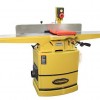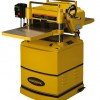A jointer can machine a face or edge of a board perfectly flat and straight. It can also make adjoining surfaces square to each other. What it can’t do is make any surfaces parallel to each other. That is the job of the thickness planer or in the case of edges, the table saw.
The jointer “sees” one surface of the wood at a time. The knives are set parallel to the outfeed table and the machined portion of the wood, sliding on that table is the only registration a jointer has. When squaring an edge, the fence comes into play but the outfeed table surface remains the only point of registration that keeps the edge straight.
The jointer has no way of keying of another surface to make a cut parallel to that surface. Consequently, while the jointer can make adjacent surfaces smooth, straight and square to each other, it has no way to make those cuts parallel to each other.
When working with edges, we often joint one edge straight and then go to the table saw to cut the opposing edge parallel to it. With the wide faces, after jointing one face flat, the planer is used to cut the opposing wide face flat and parallel to the jointed one. It this combination of machines that allows us to produce perfectly straight wood with square, parallel edges.
The curb weight of 517-lbs clearly demonstrates that POWERMATIC has not lost their penchant for heavy-duty construction. The liberal use of iron castings, thoughtful design and high-end machining make it obvious that the POWERMATIC 15HH is intended to remain in service longer than the woodworker using it may.
Further evidence of POWERMATIC’s interest in quality is the use of a genuine Tom Byrd helical cutterhead. It would have been much cheaper to produce a similar looking but less effective copy of this cutterhead design, as many others do. However, POWERMATIC chose to stick with the real deal and the extraordinary performance of the original Byrd design, materials and manufacturing.
POWERMATIC recognized that most woodworkers are likely to use this 500lb-plus planer in different parts of their shop. To make that relocation easy they added a set of wheels housed within the base cabinet. When you get to the right place, step on the foot-operated wheel lock and the POWERMATIC 15HH stays put.
One of the first things I noticed about the POWERMATIC PM2000 is that everywhere I looked there was evidence that POWERMATIC intended this to be the best table saw. Their choice of materials and machining processes clearly suggest that quality, durability and function were given higher priority than manufacturing cost.
Most noticeable are the 30-1/2″-deep (front to back) cast iron table and the large, cast iron hand wheels that operate the blade height and bevel mechanism. The chromed outer rims, painted centers and finely machined forged steel locking pins could easily have been replaced with stamped, cast or plastic parts to save a bunch of money – but weren’t.
The massive cast iron base alone is out of the ordinary to say the least. Add the retractable caster system built into it and the POWERMATIC PM2000 zooms into a world of its own.



